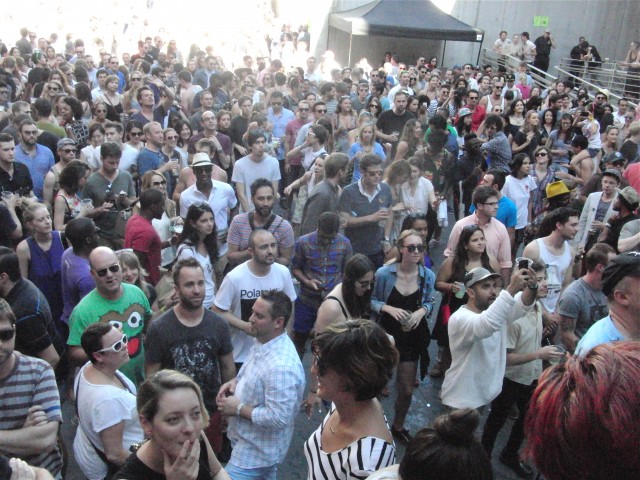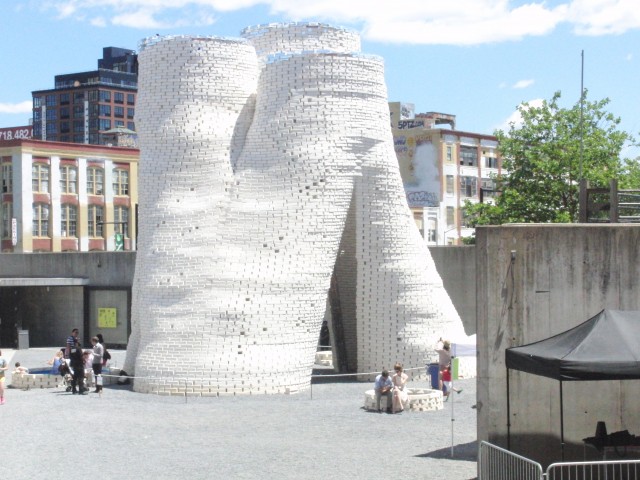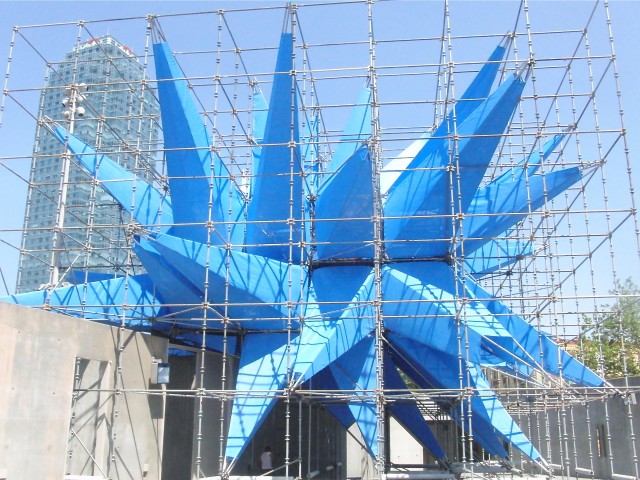MoMA PS1
22-25 Jackson Ave. at 46th Ave.
Warm Up: Saturdays through September 6, $18-$20, 3:00 – 9:00
“Hy-Fi”: Thursday – Monday through September 7, suggested admission $10 (free with paid MoMA ticket within fourteen days except during Warm Up), 12 noon – 6:00
718-784-2084
www.momaps1.org/warmup
www.momaps1.org/yap
The summer’s sweatiest dance party takes places every Saturday in Long Island City, as thousands of people gather in MoMA PS1’s courtyard for the weekly Warm Up celebration. Now in its seventeenth year, Warm Up features an international roster of prominent DJs and live performances on Saturdays from 3:00 to 9:00 on the dance floor located between the winning Young Architects Program urban design installation in the courtyard and the entrance to the old school building that became an arena for cutting-edge art back in 1971. During Warm Up, M. Wells Dinette serves alcoholic drinks indoors and hot food and cold drinks outdoors, including fried chicken, grilled mackerel yellow bean salad, a grilled veal heart hero, and maple water. On Saturdays, the exhibitions on the second and third floors close at 3:00, but the first-floor and basement shows (“Maria Lassnig,” “Korakrit Arunanondchai,” “Gavin Kenyon: Reliquary Void”) continue through 6:00. This week boasts one of the best lineups of the summer, with DJ sets by Mister Saturday Night (Eamon Harkin and Justin Carter) and Auntie Flo and live music by Cibo Matto, Archie Pelago, and Gabriel Garzón Montano; July 19 brings together Robert Hood, Objekt, Rrose, Vatican Shadow, Conatiner, and Young Male, while July 26 sees Cashmere Cat, Total Freedom, GoldLink, UNiiQU3, and Suicideyear take the stage at the top of the steps, joined by a rotating series of installations by CONFETTISYSTEM, Nightwood, the Principals, and others. Tickets are available for $18 in advance and $20 at the door; be prepared for some long lines the later you go. It’s incredibly easy to get to MoMA PS1, which is the third stop on the 7 from Grand Central. Once you get off the train, just follow the thumping music, which reverberates throughout the neighborhood.
Next to the Warm Up area, in the center of the courtyard, stands “Hy-Fi,” the winner of MoMA PS1’s fifteenth annual Young Architects Program. Created by New York-based firm the Living headed by 2013 New York Foundation for the Arts fellow David Benjamin, the three conjoined towers were made using nearly 100% fully compostable and environmentally sustainable biological technologies in collaboration with Ecovative, 3M, Advanced Metal Coatings, Shabd Simon-Alexander and Audrey Louisere, Build It Green Compost, Brooklyn Digital Foundry, Columbia University (where Benjamin is an assistant professor in the Living Architecture Lab), and others. “Hy-Fi” contains approximately ten thousand remarkably light handmade bricks consisting of such organic waste materials as cornstalks and mushroom mycelium, held together by mortar. The shiny, glittering bricks at the top are actually the molds in which the rest of the bricks were grown. (There are also several vertical wooden beams that hold up the entryways, primarily as protection against strong winds and storms, which came in handy last week.) The small gaps between some of the bricks are strictly artistic, resulting in streams of sunlight and shadows. Construction required no energy (except for human) and almost zero carbon emissions; when the installation, which also provides much-needed cooling, is brought down after September 7, the entire structure will be recycled. Unfortunately, because of the size and unpredictability of the crowds during Warm Up, on Saturdays visitors are not allowed inside the twisting structure, which was influenced by the designs of Barcelona architect Antoni Gaudí, but you can take a break in the small pool and sit in other circular areas while drinking wine, beer, and other cocktails. The Living, which was founded in 2006 with “the mission of creating the architecture of the future,” won the YAP commission this year over Collective-LOK, LAMAS, Pita + Bloom, and Fake Industries Architectural Agonism; you can currently see an exhibition on all five submissions, as well as finalists from similar competitions in Italy, Chile, and South Korea, at MoMA’s midtown location.


